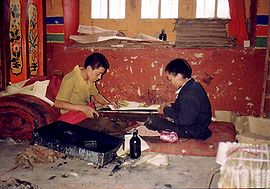
Kangyur
Encyclopedia
The Tibetan Buddhist canon
is a loosely defined list of sacred texts recognized by various schools of Tibetan Buddhism
, made up of the Kangyur or Kanjur ('The Translation of the Word') and the Tengyur or Tanjur (Tengyur
) ('Translation of Treatises').


, and Mahayana
texts, the Tibetan canon includes Tantric
texts. The last category is not always sharply distinguished from the others: the tantra division sometimes includes material usually not thought of as tantric in other traditions, such as the Heart Sutra
and even versions of material found in the Pali Canon
.
The Tibetan Canon underwent a final compilation in 14th Century by Bu-ston
(1290–1364). The Tibetans did not have a formally arranged Mahayana canon and so devised their own scheme which divided texts into two broad categories, the "Words of the Buddha" and later the commentaries; respectively the Kangyur and Tengyur
. "The Kangyur usually takes up a hundred or a hundred and eight volumes, the Tengyur two hundred and twenty-five, and the two together contain 4,569 works."
The Kangyur is divided into sections on Vinaya
, Perfection of Wisdom Sutras, other sutra
s (75% Mahayana, 25% Hinayana
), and tantra
s. It includes texts on the Vinaya
, monastic discipline, metaphysics, the Tantra
s, etc. Some describe the prajñāpāramitā
philosophy, others extol the virtues of the various Bodhisattva
s, while others expound the Trikāya
and the Ālaya-Vijñāna doctrines.
When exactly the term Kangyur was first used is not known. Collections of canonical Buddhist texts existed already in the time of Trisong Detsen
, the sixth king of Tibet
, in Spiti
, who ruled from 755 until 797 CE.
The exact number of texts in the Kangyur is not fixed, each editor takes responsibility for removing texts he considers spurious, and adding new translations. Currently there are about 12 available versions of the Kangyur. These include the Derge
, Lhasa
, Narthang
, Cone
, Peking, Urga, Phudrak, and Stog Palace versions, each named after the physical location of its printing. In addition some canonical texts have been found in Tabo Monastery
and Dunhuang
which provide earlier exemplars to texts found in the Kangyur. All extant Kangyur appear to stem from the Old Narthang Monastery
Kangyur. The stemma of the Kangyur have been well researched in particular by Helmut Eimer.
Tibetan Buddhist canon
The Tibetan Buddhist canon is a loosely defined list of sacred texts recognized by various sects of Tibetan Buddhism. In addition to sutrayana texts from Early Buddhist and Mahayana sources, the Tibetan canon includes tantric texts...
is a loosely defined list of sacred texts recognized by various schools of Tibetan Buddhism
Tibetan Buddhism
Tibetan Buddhism is the body of Buddhist religious doctrine and institutions characteristic of Tibet and certain regions of the Himalayas, including northern Nepal, Bhutan, and India . It is the state religion of Bhutan...
, made up of the Kangyur or Kanjur ('The Translation of the Word') and the Tengyur or Tanjur (Tengyur
Tengyur
The Tengyur or Tanjur is the Tibetan collection of commentaries to the Buddhist teachings, or "Translated Treatises"...
) ('Translation of Treatises').


The Tibetan Buddhist Canon
In addition to earlier foundational Buddhist texts from early Buddhist schools, mostly the SarvastivadaSarvastivada
The Sarvāstivāda were an early school of Buddhism that held to 'the existence of all dharmas in the past, present and future, the 'three times'. Vasubandhu's states:-Name:...
, and Mahayana
Mahayana
Mahāyāna is one of the two main existing branches of Buddhism and a term for classification of Buddhist philosophies and practice...
texts, the Tibetan canon includes Tantric
Vajrayana
Vajrayāna Buddhism is also known as Tantric Buddhism, Tantrayāna, Mantrayāna, Secret Mantra, Esoteric Buddhism and the Diamond Vehicle...
texts. The last category is not always sharply distinguished from the others: the tantra division sometimes includes material usually not thought of as tantric in other traditions, such as the Heart Sutra
Heart Sutra
The Heart Sūtra is a Mahāyāna Buddhist sūtra. Its Sanskrit name literally translates to "Heart of the Perfection of Transcendent Wisdom." The Heart Sūtra is often cited as the best known and most popular of all Buddhist scriptures.-Introduction:The Heart Sūtra is a member of the Perfection of...
and even versions of material found in the Pali Canon
Pāli Canon
The Pāli Canon is the standard collection of scriptures in the Theravada Buddhist tradition, as preserved in the Pāli language. It is the only completely surviving early Buddhist canon, and one of the first to be written down...
.
The Tibetan Canon underwent a final compilation in 14th Century by Bu-ston
Buton Rinchen
Buton Rinchen Drub , , 11th Abbot of Shalu Monastery, was a fourteenth century Sakya master and Tibetan Buddhist leader...
(1290–1364). The Tibetans did not have a formally arranged Mahayana canon and so devised their own scheme which divided texts into two broad categories, the "Words of the Buddha" and later the commentaries; respectively the Kangyur and Tengyur
Tengyur
The Tengyur or Tanjur is the Tibetan collection of commentaries to the Buddhist teachings, or "Translated Treatises"...
. "The Kangyur usually takes up a hundred or a hundred and eight volumes, the Tengyur two hundred and twenty-five, and the two together contain 4,569 works."
- Kangyur (Wylie: Bka'-'gyur) or "Translated Words" consists of works in about 108 volumes supposed to have been spoken by the Buddha himself. All texts presumably had a Sanskrit original, although in many cases the Tibetan text was translated from ChineseChinese languageThe Chinese language is a language or language family consisting of varieties which are mutually intelligible to varying degrees. Originally the indigenous languages spoken by the Han Chinese in China, it forms one of the branches of Sino-Tibetan family of languages...
or other languages.
- Tengyur (Wylie: Bstan-'gyur) or "Translated Treatises" is the section to which were assigned commentaries, treatises and abhidharmaAbhidharmaAbhidharma or Abhidhamma are ancient Buddhist texts which contain detailed scholastic and scientific reworkings of doctrinal material appearing in the Buddhist Sutras, according to schematic classifications...
works (both Mahayana and non-Mahayana). The Tengyur contains around 3,626 texts in 224 Volumes.
The Kangyur is divided into sections on Vinaya
Vinaya
The Vinaya is the regulatory framework for the Buddhist monastic community, or sangha, based in the canonical texts called Vinaya Pitaka. The teachings of the Buddha, or Buddhadharma can be divided into two broad categories: 'Dharma' or doctrine, and 'Vinaya', or discipline...
, Perfection of Wisdom Sutras, other sutra
Buddhist texts
Buddhist texts can be categorized in a number of ways. The Western terms "scripture" and "canonical" are applied to Buddhism in inconsistent ways by Western scholars: for example, one authority refers to "scriptures and other canonical texts", while another says that scriptures can be categorized...
s (75% Mahayana, 25% Hinayana
Hinayana
Hīnayāna is a Sanskrit and Pāli term literally meaning: the "Inferior Vehicle", "Deficient Vehicle", the "Abandoned Vehicle", or the "Defective Vehicle". The term appeared around the 1st or 2nd century....
), and tantra
Tantra
Tantra , anglicised tantricism or tantrism or tantram, is the name scholars give to an inter-religious spiritual movement that arose in medieval India, expressed in scriptures ....
s. It includes texts on the Vinaya
Vinaya
The Vinaya is the regulatory framework for the Buddhist monastic community, or sangha, based in the canonical texts called Vinaya Pitaka. The teachings of the Buddha, or Buddhadharma can be divided into two broad categories: 'Dharma' or doctrine, and 'Vinaya', or discipline...
, monastic discipline, metaphysics, the Tantra
Tantra
Tantra , anglicised tantricism or tantrism or tantram, is the name scholars give to an inter-religious spiritual movement that arose in medieval India, expressed in scriptures ....
s, etc. Some describe the prajñāpāramitā
Prajnaparamita
Prajñāpāramitā in Buddhism, means "the Perfection of Wisdom." The word Prajñāpāramitā combines the Sanskrit words prajñā with pāramitā . Prajñāpāramitā is a central concept in Mahāyāna Buddhism and its practice and understanding are taken to be indispensable elements of the Bodhisattva Path...
philosophy, others extol the virtues of the various Bodhisattva
Bodhisattva
In Buddhism, a bodhisattva is either an enlightened existence or an enlightenment-being or, given the variant Sanskrit spelling satva rather than sattva, "heroic-minded one for enlightenment ." The Pali term has sometimes been translated as "wisdom-being," although in modern publications, and...
s, while others expound the Trikāya
Trikaya
The Trikāya doctrine is an important Mahayana Buddhist teaching on both the nature of reality and the nature of a Buddha. By the 4th century CE the Trikāya Doctrine had assumed the form that we now know...
and the Ālaya-Vijñāna doctrines.
When exactly the term Kangyur was first used is not known. Collections of canonical Buddhist texts existed already in the time of Trisong Detsen
Trisong Detsen
Trisong Detsän or Trisong Detsen ཁྲི་སྲོང་ལྡེ་བཙན , was the son of Me Agtsom and one of the emperors of Tibet and ruled...
, the sixth king of Tibet
Tibet
Tibet is a plateau region in Asia, north-east of the Himalayas. It is the traditional homeland of the Tibetan people as well as some other ethnic groups such as Monpas, Qiang, and Lhobas, and is now also inhabited by considerable numbers of Han and Hui people...
, in Spiti
Spiti
-Geographical locations:*Lahaul and Spiti, a district in the state of Himachal Pradesh in India.*Spiti Valley, former heartland of the former Spiti district now combined.*Spiti River, in the Spiti Valley, Himachal Pradesh.*Spitia River-Language:...
, who ruled from 755 until 797 CE.
The exact number of texts in the Kangyur is not fixed, each editor takes responsibility for removing texts he considers spurious, and adding new translations. Currently there are about 12 available versions of the Kangyur. These include the Derge
Dergé
Dêgê County is a county in Garzê Tibetan Autonomous Prefecture in China's Sichuan province. Its county seat is the town of Dêgê. It was once the location of the Kingdom of Dêgê.-External links:*...
, Lhasa
Lhasa
Lhasa is the administrative capital of the Tibet Autonomous Region in the People's Republic of China and the second most populous city on the Tibetan Plateau, after Xining. At an altitude of , Lhasa is one of the highest cities in the world...
, Narthang
Narthang Monastery
Narthang Monastery is a monastery located west of Shigatse in Tibet. Founded in 1153 by one of the disciples of Atisha, Nathang was the fourth great monastery of Tsang with Shalu Monastery, Sakya and Tashilhunpo. Narthang was first famous for its scriptual teaching and monastic discipline...
, Cone
Cuona County
Cuona County, is a county of the Shannan Prefecture located in the far south-east of the Tibet Autonomous Region, People's Republic of China. Eaglenest Wildlife Sanctuary is located here. India claimed this county as part of Arunachal Pradesh, which is a disputed area between People's Republic of...
, Peking, Urga, Phudrak, and Stog Palace versions, each named after the physical location of its printing. In addition some canonical texts have been found in Tabo Monastery
Tabo Monastery
Tabo Monastery was founded in 996 CE in the Spiti Valley, Himachel Pradesh, India by the great Tibetan Buddhist lotswa , Rinchen Zangpo, the king of western Himalayan Kingdom of Guge...
and Dunhuang
Dunhuang
Dunhuang is a city in northwestern Gansu province, Western China. It was a major stop on the ancient Silk Road. It was also known at times as Shāzhōu , or 'City of Sands', a name still used today...
which provide earlier exemplars to texts found in the Kangyur. All extant Kangyur appear to stem from the Old Narthang Monastery
Narthang Monastery
Narthang Monastery is a monastery located west of Shigatse in Tibet. Founded in 1153 by one of the disciples of Atisha, Nathang was the fourth great monastery of Tsang with Shalu Monastery, Sakya and Tashilhunpo. Narthang was first famous for its scriptual teaching and monastic discipline...
Kangyur. The stemma of the Kangyur have been well researched in particular by Helmut Eimer.
The Bon Kangyur
The Tibetan Bön religion also has its canon literature divided into two sections called the Kangyur and Tengyur claimed to have been translated from foreign languages but the number and contents of the collection are not yet fully known. Apparently, Bon began to take on a literary form about the time Buddhism began to enter Tibet. The Bon Kangyur contains the revelations of Shenrab (Wylie: gShen rab, the traditional founder of Bon. A version was published in 1993-1997.External links
- The Tibetan Buddhist Resource Center
- Kangyur @Rigpawiki

